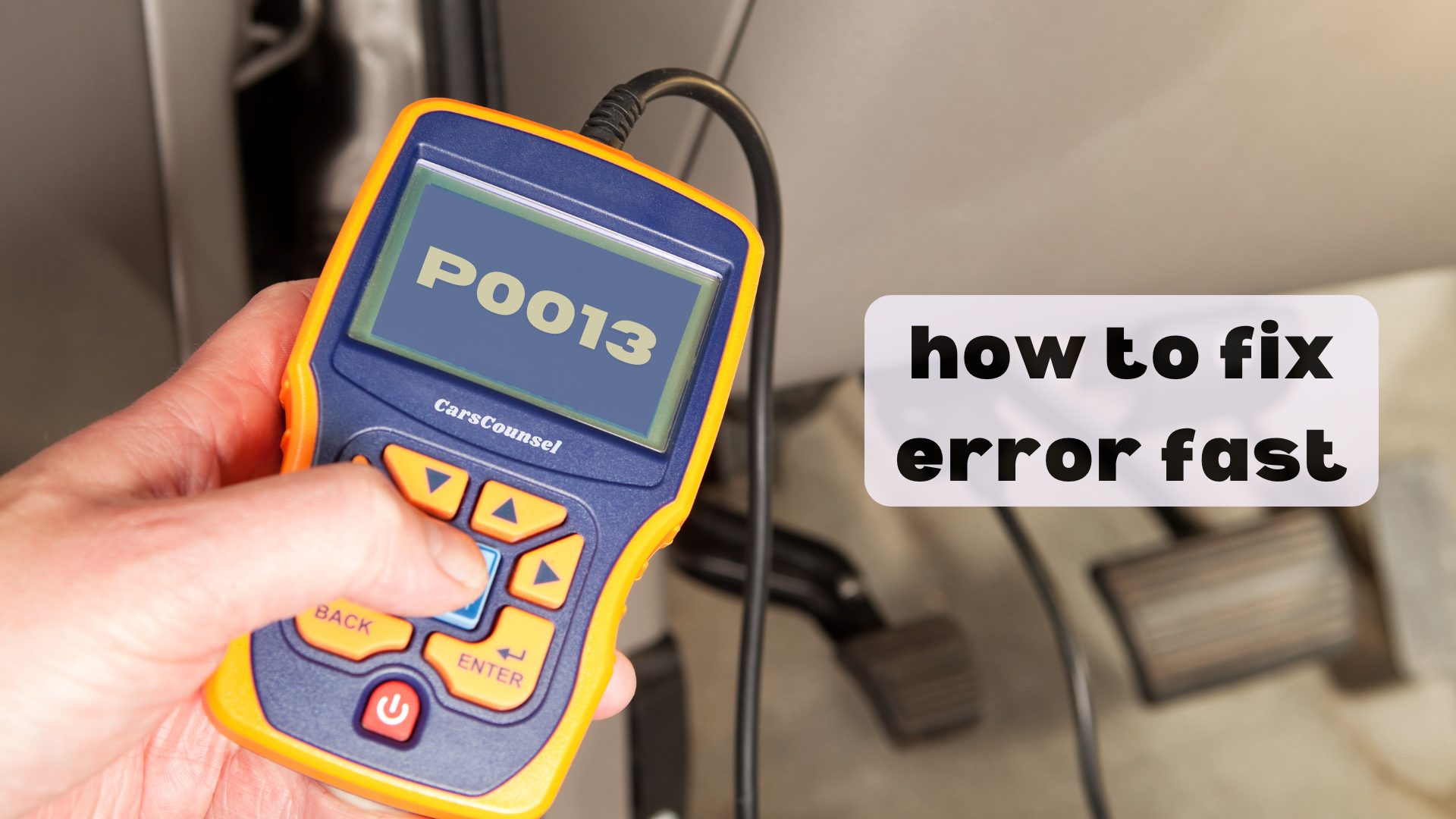Did you know that almost 30% of drivers see a check engine light because of camshaft position actuator problems like the P0013 code? If you’re dealing with this error, it can be really annoying, but don’t worry—you can fix it quickly.
Start with the basics: check your engine oil level and quality. Dirty or low oil can mess up the actuator’s function.
Next, look at the camshaft position actuator solenoid and its wiring for any wear and tear.
Testing the camshaft position sensor with a multimeter is also important.
Ready to get your engine running smoothly again? Here’s what you need to do next.

Quick Navigation
Key Takeaways
- Replace the broken camshaft position actuator solenoid to fix the oil flow.
- Check and tighten all wiring and connectors to make sure everything is connected.
- Regularly change the oil and keep it at the right level to prevent clogs and keep the actuator working well.
- Use a multimeter to test the camshaft position sensor and make sure it’s not faulty.
Understanding the P0013 Code
The P0013 code, which is a part of a larger set of OBD2 Codes, means there’s a problem with the exhaust camshaft position actuator circuit on bank 1. This mainly affects cars with variable valve timing (VVT) systems.
It’s important because it can mess up the timing of your camshaft, which is crucial for your engine’s performance. If this part isn’t working right, your car might idle roughly, accelerate poorly, and use more fuel than usual.
Understanding this code helps you see its role in controlling the exhaust camshaft’s timing. Fixing it quickly ensures your engine runs smoothly and efficiently, preventing more serious issues.
Always check the actuator performance to keep your car running well and to save on fuel.
Camshaft Position Actuator Issues
To fix the P0013 code, you need to understand the common problems with the camshaft position actuator, especially in cars with Variable Valve Timing (VVT) systems.
If you don’t take care of the actuator, it can cause timing issues. Regularly check the actuator’s solenoid, as it controls the oil flow to the camshaft and can wear out or malfunction.
Make sure the actuator gets clean oil at the right pressure. Look for any electrical or wiring problems that could mess up the actuator’s operation.
Good maintenance includes replacing faulty parts on time and ensuring all connections are secure. This proactive approach helps keep the camshaft working well and prevents the P0013 code from appearing.
Common Causes of P0013
If your car shows a P0013 code, it usually means there’s an issue with the camshaft timing. Here are some common causes:
- Faulty Camshaft Position Actuator Solenoid: This part helps control the flow of oil to the camshaft. If it’s not working properly, it can mess up the timing.
- Timing Chain Problems: If the timing chain is worn out or stretched, it can throw off the camshaft’s position and trigger the P0013 code.
- Failed Camshaft Position Sensors: These sensors tell the car’s computer where the camshaft is. If they give wrong information, it can cause timing issues.
- Electrical or Wiring Issues: Broken wires or loose connections can mess with the sensors and cause problems.
- Poor Oil Quality or Low Oil Levels: Dirty or low oil can affect the actuator’s performance, leading to bad camshaft timing and the P0013 code.
In short, if you get a P0013 code, check these parts and issues to find the problem.
Symptoms to Watch For
When your car shows a P0013 code, you might notice it runs rough when idling and doesn’t speed up well. These problems usually mean something is wrong with the engine. Here’s what to look out for:
- Rough Idling: The engine might feel shaky or unstable when you’re not pressing the gas, which could be a camshaft problem.
- Poor Acceleration: If your car takes a while to speed up or doesn’t respond well when you press the gas, the exhaust camshaft position actuator might be acting up.
- Check Engine Light: The check engine light will probably be on, indicating you need to use diagnostic tools to find out what’s wrong.
Impact on Driving Performance
A P0013 code can mess up how your car drives, causing rough idling, poor acceleration, and lower fuel efficiency. This means your engine isn’t working as well as it should, which affects your driving experience.
Rough idling can make your ride bumpy and unpredictable, while poor acceleration makes it hard to merge or pass other cars safely. Lower fuel efficiency means you’ll have to fill up more often, costing you more money.
Ignoring this code can lead to more serious engine damage and even cause your car to stall, leaving you stuck. Fixing the P0013 code quickly ensures your car runs smoothly, keeps your engine in good shape, and allows for safe driving.
Don’t wait—get it fixed fast to avoid bigger problems down the road.
Affected Vehicle Models
Common Cars with P0013 Issues
The P0013 trouble code often shows up in certain cars, especially those with Variable Valve Timing (VVT) systems. If you’re trying to fix engine problems, it’s helpful to know which models are most commonly affected. Here are three popular ones:
- Chevy Malibu (2010-2012): These cars often have solenoid problems, which can mess up your maintenance schedule.
- Chevy Equinox (2010-2012): This model frequently runs into P0013 issues, needing thorough engine checks.
- Buick Verano (2012): Tends to have problems with the oil flow control valve, leading to P0013 errors.
These cars need regular engine checks and maintenance to avoid and fix the P0013 code.
Keeping up with routine inspections and acting quickly can help keep your car running smoothly and efficiently.
Checking Engine Oil
Checking your engine oil is crucial for keeping your car running smoothly and avoiding the P0013 error code. Start by using the dipstick to check if the oil level is correct. If the oil level is too low, it can mess up the camshaft position actuator and cause performance problems.
Next, look at the oil’s quality. If it looks dirty or has particles in it, change it right away because dirty oil can clog the actuator and affect how your engine works.
Regular oil changes are important not just to avoid P0013, but to keep your engine in good shape overall. Always use the type of oil recommended by the manufacturer and stick to a regular oil change schedule.
Ignoring oil maintenance can lead to bigger problems than just the P0013 code.
Inspecting Wiring and Connections
Checking the wires and connections means looking for any broken wires or loose connections that could mess up the camshaft position actuator’s job. Making sure the wires are in good shape and the connections are solid is key to fixing the P0013 code.
Here’s what to do:
- Look Closely: Check the wires and connectors near the camshaft position actuator for any obvious damage or rust.
- Test the Wires: Use a multimeter to check if the wires have a good connection and aren’t broken or shorted.
- Tighten Connections: Make sure all connectors are securely attached and clean, so they connect well.
Testing Camshaft Position Sensor
To test the camshaft position sensor, start by using a multimeter to check the sensor’s voltage and resistance.
First, unplug the sensor’s connector and set your multimeter to measure voltage. Connect the meter’s leads to the sensor’s terminals, then turn the ignition key to the ‘on’ position without starting the engine. You should see a voltage reading that matches the manufacturer’s specifications.
Next, check the sensor’s resistance. Set the multimeter to measure ohms and check the resistance between the sensor’s terminals. If the resistance is different from what the manufacturer specifies, the sensor may need adjustment.
Accurate readings will help diagnose the P0013 code correctly and avoid unnecessary part replacements.
Replacing Faulty Components
After confirming that the camshaft position sensor is working properly, you’ll need to replace any faulty parts to fix the P0013 code. Make sure the new parts are compatible with your vehicle.
Here are the main steps:
- Replace the camshaft position actuator solenoid: Ensure the new solenoid fits your vehicle’s specifications.
- Inspect and replace the timing chain if needed: Check for wear or stretching and use a chain that matches your vehicle model.
- Check and replace faulty wiring or connectors: Ensure all electrical connections are secure and replace any damaged wires with parts that fit your vehicle.
More OBD-II Codes
Frequently Asked Questions
Can a P0013 Code Affect Emissions Test Results?
Yes, a P0013 code can affect your emissions test results. You should fix it quickly because it impacts emissions. Proper diagnostics are key to finding and fixing the problem, which helps keep your vehicle running well.
Is There a Temporary Fix for P0013 Until Professional Repair?
Think of it as a quick patch for your car. For a temporary fix, you can check and add engine oil, clean the camshaft position sensor, and look at the wiring connections to make sure they’re okay. These simple steps might help until you can get professional repair.
What Are the Costs Associated With Fixing a P0013 Code?
Fixing a P0013 code usually costs between $150 and $500. You’ll also need to pay for a diagnostic check, which can add another $50 to $150. The total cost depends on what’s causing the problem, like if you need to replace the camshaft position actuator solenoid or fix some wiring issues.
How Long Does It Take to Repair a P0013 Code Issue?
The time it takes to fix a P0013 code can differ. Checking the oil, looking at the wiring, and testing sensors might take a few hours. If you need to replace any bad parts, it could take up to a day.
Can Weather Conditions Influence the Occurrence of a P0013 Code?
Yes, the weather can affect a P0013 code. Changes in temperature can impact how thick or thin the oil is and how well electrical connections work. In very cold weather, the oil can get thicker and not flow as well. On the other hand, hot weather can cause wires to degrade, which can lead to circuit problems.
Conclusion
So, you’ve checked the oil, looked at the wiring, and tested the sensor—what’s next?
If you found any bad parts, replace them with the right ones to make sure everything fits properly.
This simple and straightforward approach will get your engine running smoothly again and keep other problems from popping up.
Can you imagine driving without that annoying P0013 code?
By following these steps, you’ll be back to having a reliable and error-free car in no time.

